CHEVROLET SUBURBAN 2002 9.G Owners Manual
Manufacturer: CHEVROLET, Model Year: 2002, Model line: SUBURBAN, Model: CHEVROLET SUBURBAN 2002 9.GPages: 443, PDF Size: 2.92 MB
Page 311 of 443
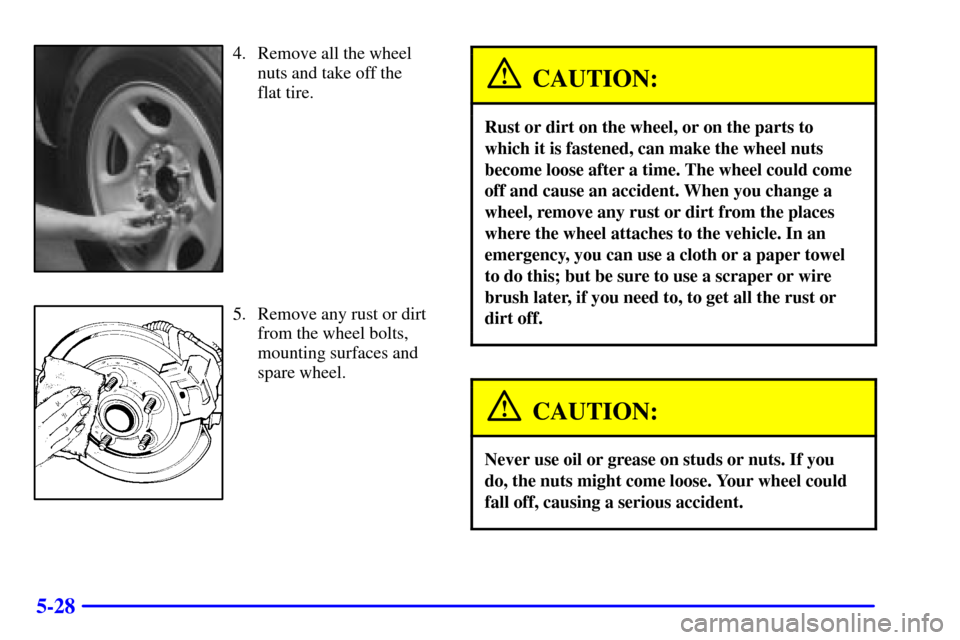
5-28
4. Remove all the wheel
nuts and take off the
flat tire.
5. Remove any rust or dirt
from the wheel bolts,
mounting surfaces and
spare wheel.
CAUTION:
Rust or dirt on the wheel, or on the parts to
which it is fastened, can make the wheel nuts
become loose after a time. The wheel could come
off and cause an accident. When you change a
wheel, remove any rust or dirt from the places
where the wheel attaches to the vehicle. In an
emergency, you can use a cloth or a paper towel
to do this; but be sure to use a scraper or wire
brush later, if you need to, to get all the rust or
dirt off.
CAUTION:
Never use oil or grease on studs or nuts. If you
do, the nuts might come loose. Your wheel could
fall off, causing a serious accident.
Page 312 of 443
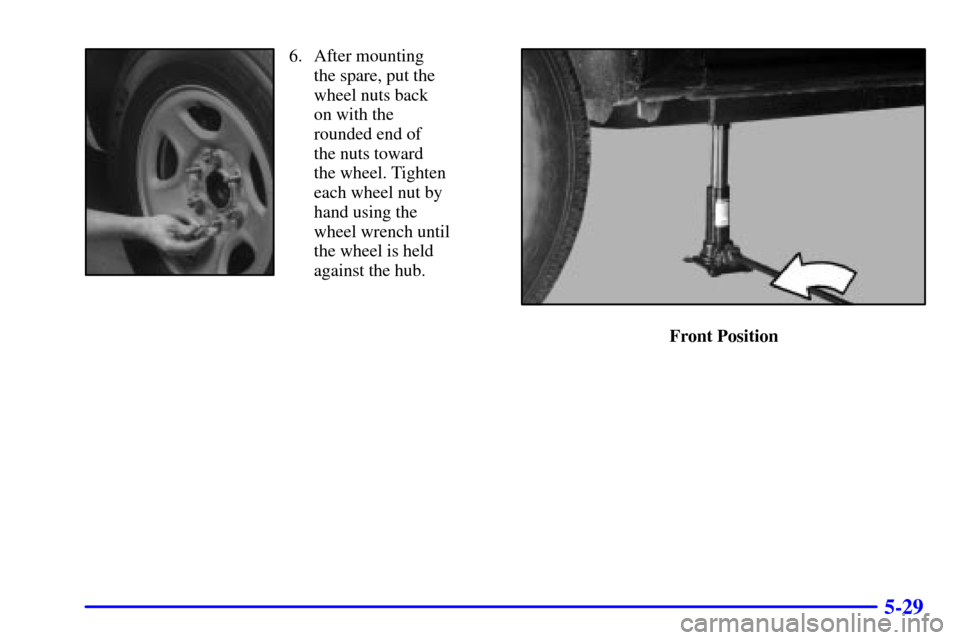
5-29
6. After mounting
the spare, put the
wheel nuts back
on with the
rounded end of
the nuts toward
the wheel. Tighten
each wheel nut by
hand using the
wheel wrench until
the wheel is held
against the hub.
Front Position
Page 313 of 443

5-30
Rear Position
1500 SeriesRear Position
2500 Series
7. Turn the wheel wrench counterclockwise to lower
the vehicle. Lower the jack completely.
8. Tighten the nuts firmly in a crisscross sequence as
shown by turning the wheel wrench clockwise.
Page 314 of 443
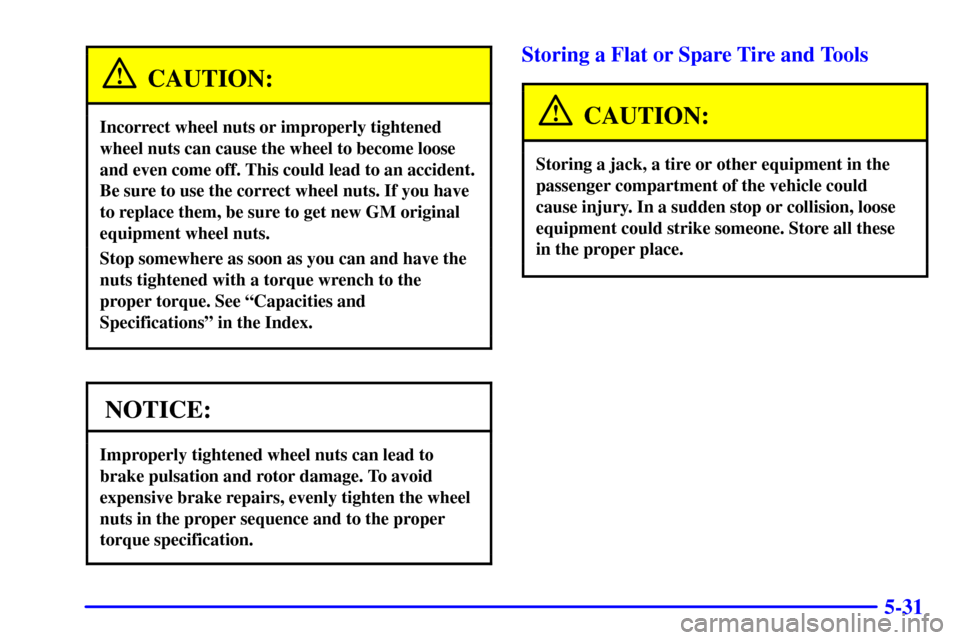
5-31
CAUTION:
Incorrect wheel nuts or improperly tightened
wheel nuts can cause the wheel to become loose
and even come off. This could lead to an accident.
Be sure to use the correct wheel nuts. If you have
to replace them, be sure to get new GM original
equipment wheel nuts.
Stop somewhere as soon as you can and have the
nuts tightened with a torque wrench to the
proper torque. See ªCapacities and
Specificationsº in the Index.
NOTICE:
Improperly tightened wheel nuts can lead to
brake pulsation and rotor damage. To avoid
expensive brake repairs, evenly tighten the wheel
nuts in the proper sequence and to the proper
torque specification.
Storing a Flat or Spare Tire and Tools
CAUTION:
Storing a jack, a tire or other equipment in the
passenger compartment of the vehicle could
cause injury. In a sudden stop or collision, loose
equipment could strike someone. Store all these
in the proper place.
Page 315 of 443

5-32
Store the flat tire where the spare tire was stored.
To store the tire:
1. Put the tire on the ground at the rear of the vehicle
with the valve stem pointed upward.
2. Tilt the retainer downward and through the wheel
opening. Make sure the retainer is fully seated across
the underside of the wheel.
3. Attach the wheel wrench and extensions together.
Insert the hoist end through the hole in the rear
bumper and into the hoist shaft.
4. Raise the tire part way upward. Make sure the
retainer is seated in the wheel opening.
5. Raise the tire fully against the underside of the
vehicle. Continue turning the wheel wrench until the
tire is secure and the cable is tight. The spare tire
hoist cannot be overtightened.
6. Make sure the tire is stored securely. Push, pull, and
then try to rotate or turn the tire. If the tire moves,
use the wheel wrench to tighten the cable.
Put back the jack, tools and spare tire lock.
Page 316 of 443

5-33
A. Hoist Assembly
B. Wheel Wrench
C. Jack
Handle Extensions
D. Hoist ShaftE. Valve Stem,
Pointed Up
F. Flat or Spare Tire
G. Tire Retainer
H. Hoist CableTo store the tools, follow these procedures:
For Tahoe/Yukon models do the following:
1. Put the tool kit, with the jack tools and gloves,
in the tool bag and place in the retaining clip
under the driver's side second seat.
2. Tighten down with the wing nut.
3. Then, assemble wheel chocks and bottle jack
together with the wing nut and retaining hook.
4. Position behind the jack storage cover in the left
rear side panel just below the speaker and tighten,
adjusting clockwise until the jack is secured tight
in the mounting bracket. Be sure to position the
holes in the base of the jack onto the pin in the
mounting bracket.
Page 317 of 443

5-34
For Suburban/Yukon XL models do the following:
1. Return the tool kit (jack tools and gloves) to the
tool bag.
2. Assemble wheel chocks and bottle jack together with
the wing nut and retaining hook.
3. Position under the jack storage tray in the left
rear side panel below the wheelbase and tighten,
adjusting clockwise until the jack is secured tight
in the mounting bracket. Be sure to position the
holes in the base of the jack onto the pin in the
mounting bracket.
4. Use the retaining clip to fasten the tool kit on the
stud in the storage compartment in the rear left trim
panel and turn the wing nut clockwise to secure.
5. Return the storage tray.
Tahoe/Yukon Models
(Under Driver's Side Rear Seat)
A. Tool Kit with Jack Tools and Gloves
B. Bracket and Wing Nut
Page 318 of 443

5-35
Tahoe/Yukon Models (Rear Access Panel)
A. Speaker
B. Bottle Jack
C. Wing Nut
D. Retaining Hook
E. Tire Blocks
F. Cover Panel
Suburban/Yukon XL Models
A. Bottle Jack
B. Wheel Blocks
C. Wing Nut
D. Mounting Bracket
E. Removable TrayF. Retaining Hook
G. Retaining Bracket
and Wing Nut
H. Tool Kit with Jack
Tools and Gloves
Page 319 of 443
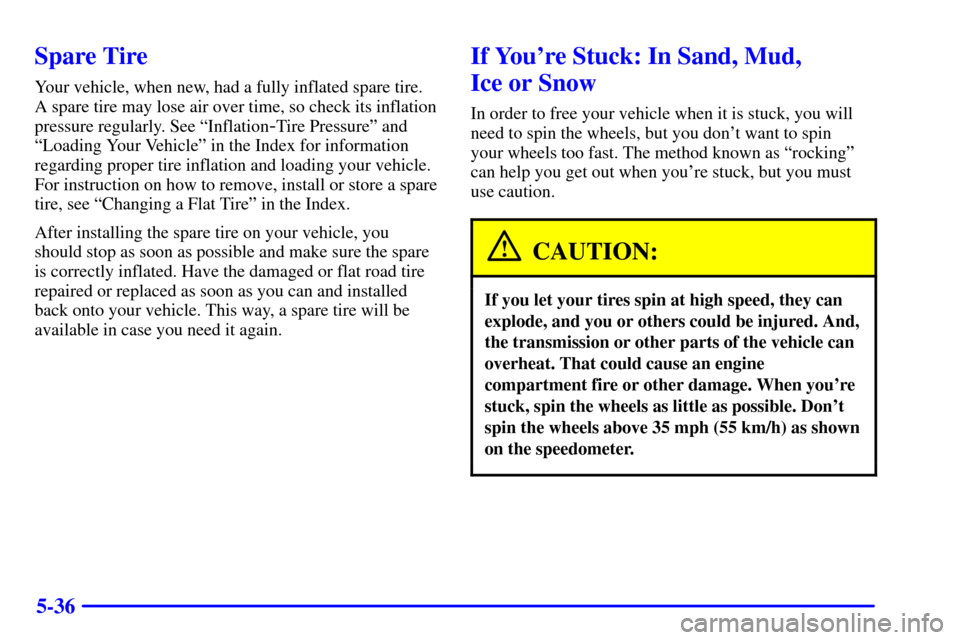
5-36
Spare Tire
Your vehicle, when new, had a fully inflated spare tire.
A spare tire may lose air over time, so check its inflation
pressure regularly. See ªInflation
-Tire Pressureº and
ªLoading Your Vehicleº in the Index for information
regarding proper tire inflation and loading your vehicle.
For instruction on how to remove, install or store a spare
tire, see ªChanging a Flat Tireº in the Index.
After installing the spare tire on your vehicle, you
should stop as soon as possible and make sure the spare
is correctly inflated. Have the damaged or flat road tire
repaired or replaced as soon as you can and installed
back onto your vehicle. This way, a spare tire will be
available in case you need it again.
If You're Stuck: In Sand, Mud,
Ice or Snow
In order to free your vehicle when it is stuck, you will
need to spin the wheels, but you don't want to spin
your wheels too fast. The method known as ªrockingº
can help you get out when you're stuck, but you must
use caution.
CAUTION:
If you let your tires spin at high speed, they can
explode, and you or others could be injured. And,
the transmission or other parts of the vehicle can
overheat. That could cause an engine
compartment fire or other damage. When you're
stuck, spin the wheels as little as possible. Don't
spin the wheels above 35 mph (55 km/h) as shown
on the speedometer.
Page 320 of 443
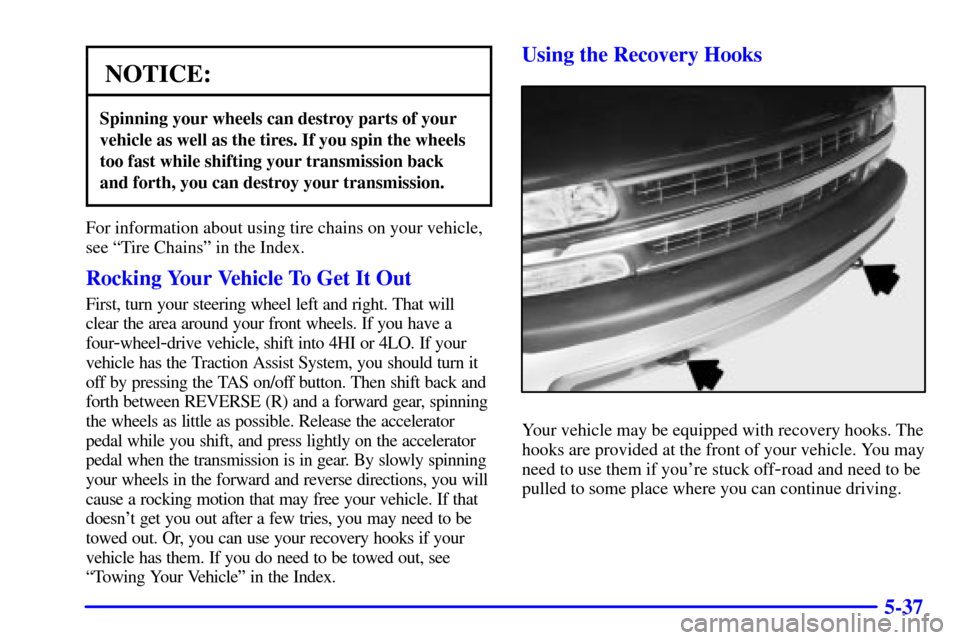
5-37
NOTICE:
Spinning your wheels can destroy parts of your
vehicle as well as the tires. If you spin the wheels
too fast while shifting your transmission back
and forth, you can destroy your transmission.
For information about using tire chains on your vehicle,
see ªTire Chainsº in the Index.
Rocking Your Vehicle To Get It Out
First, turn your steering wheel left and right. That will
clear the area around your front wheels. If you have a
four
-wheel-drive vehicle, shift into 4HI or 4LO. If your
vehicle has the Traction Assist System, you should turn it
off by pressing the TAS on/off button. Then shift back and
forth between REVERSE (R) and a forward gear, spinning
the wheels as little as possible. Release the accelerator
pedal while you shift, and press lightly on the accelerator
pedal when the transmission is in gear. By slowly spinning
your wheels in the forward and reverse directions, you will
cause a rocking motion that may free your vehicle. If that
doesn't get you out after a few tries, you may need to be
towed out. Or, you can use your recovery hooks if your
vehicle has them. If you do need to be towed out, see
ªTowing Your Vehicleº in the Index.
Using the Recovery Hooks
Your vehicle may be equipped with recovery hooks. The
hooks are provided at the front of your vehicle. You may
need to use them if you're stuck off
-road and need to be
pulled to some place where you can continue driving.